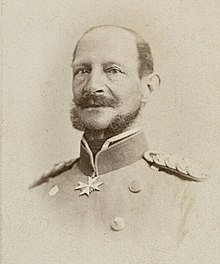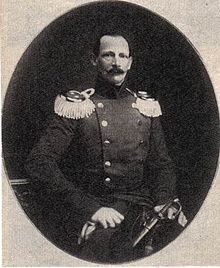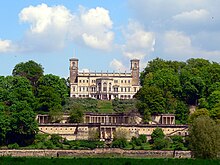Prince Albert of Prussia (1809–1872)
| Prince Albert of Prussia | |||||
|---|---|---|---|---|---|
 Prince Albert, c. 1860s | |||||
| Born | 4 October 1809 Königsberg | ||||
| Died | 14 October 1872 (aged 63) Berlin | ||||
| Burial | Charlottenburg Palace Park Mausoleum, Berlin | ||||
| Spouse | |||||
| Issue |
| ||||
| |||||
| House | Hohenzollern | ||||
| Father | Frederick William III of Prussia | ||||
| Mother | Louise of Mecklenburg-Strelitz | ||||
| Prussian Royalty |
| House of Hohenzollern |
|---|
 |
| Frederick William III |
|
Prince Frederick Henry Albert of Prussia[citation needed] (German: Friedrich Heinrich Albrecht; 4 October 1809 – 14 October 1872) was the fifth son and youngest child of King Frederick William III of Prussia and Louise of Mecklenburg-Strelitz. His parents had fled to East Prussia after the occupation of Berlin by Napoleon, and Albert was born in Königsberg. Two of Albert's elder brothers were Frederick William IV, King of Prussia from 1840 till 1861, and William I, King of Prussia from 1861 to 1888 and German Emperor from 1871 until 1888.
Career
[edit]
In 1819 he joined the Prussian Army as a lieutenant and held the rank of a general of cavalry in 1852. He took part in the 1866 Austro-Prussian War as a cavalry corps commander at the battles of Gitschin and Königgrätz. In the Franco-Prussian War of 1870/71 he led a cavalry division at the battles of Wissembourg, Wörth and Sedan. He later joined the forces of his nephews Prince Frederick Charles of Prussia and Frederick Francis II, Grand Duke of Mecklenburg-Schwerin in the campaign against the Armée de la Loire.
After the war Albert was awarded the title of a Generaloberst. He died in Berlin, where he is buried at the Charlottenburg Palace Park Mausoleum.
He was the 74th Grand Cross of the Order of the Tower and Sword.
Family
[edit]In The Hague, on 14 September 1830 Albert married his first cousin Princess Marianne, daughter of King William I of the Netherlands. The marriage was dissolved on 28 March 1849. They had five children:
- Charlotte (b. Schloss Schönhausen, near Berlin, 21 June 1831 - d. Meiningen, 30 March 1855), married on 18 May 1850 to the future Georg II, Duke of Saxe-Meiningen.
- A son (Prinz-Albrecht-Palais, Wilhelmstraße, near Berlin, 4 December 1832). He was either stillborn or lived only a few hours.[1]
- Albert (b. Berlin, 8 May 1837 - d. Kamenz, 13 September 1906), married Princess Marie of Saxe-Altenburg, had 3 sons.
- Elisabeth (b. Kamenz, 27 August 1840 - d. Kamenz, 9 October 1840).
- Alexandrine (b. Berlin, 1 February 1842 - d. Schloss Marley, near Potsdam, 26 March 1906), married on 9 December 1865 to Duke William of Mecklenburg-Schwerin.
In Berlin on 13 June 1853, Albert married secondly Rosalie Wilhelmine Johanna von Rauch, daughter of Gustav von Rauch, chief of the Prussian General Staff 1812-1813 and Prussian Minister of War 1837–1841. She was created Countess of Hohenau on 28 May 1853. They had two sons:
- Georg Albrecht Wilhelm, Count of Hohenau (b. Albrechtsberg Castle, 25 April 1854 - d. Bad Flinsburg, 28 October 1930). He married Princess Margarethe of Hohenlohe-Öhringen (1865-1940), daughter of Hugo zu Hohenlohe-Öhringen.
- Bernhard Wilhelm Albrecht Frederick, Count of Hohenau (b. Albrechtsberg Castle, 21 May 1857 - d. Ochelhermsdorf, 15 April 1914).

As this second union was considered a morganatic marriage, the couple temporarily had to avoid the Prussian court. Albert acquired a vineyard in Loschwitz near Dresden, Saxony, where he had a residence, Albrechtsberg Castle, erected in 1854.
Aftermath
[edit]In 1830 Albert had acquired a city palace in Berlin on Wilhelmstraße, then called Prinz-Albrecht-Palais. An adjacent street off Wilhelmstraße laid out in 1891 was named Prinz-Albrecht-Straße. After the Nazi Machtergreifung it became notorious as the seat of the Gestapo and the Reichsführer-SS. The Prinz-Albrecht-Palais itself from 1934 served as the headquarters of the SS Sicherheitsdienst under Reinhard Heydrich, from 1939 the Reichssicherheitshauptamt. In 1944 the building was heavily damaged by air raids and finally razed to the ground in 1955, leaving the foundations and cellars exposed to the open air. They remain so today, and are used as part of the Topography of Terror project.
Honours
[edit]- German orders and decorations[2]
 Prussia:
Prussia:
- Knight of the Black Eagle, 4 October 1819;[3] with Collar, 1827
- Grand Cross of the Red Eagle, with Oak Leaves and Swords
- Pour le Mérite (military), 31 July 1866; with Oak Leaves, 31 December 1870[4]
- Knight of the Royal Crown Order, 1st Class with Swords
- Grand Commander's Cross of the Royal House Order of Hohenzollern
- Service Award Cross
 Hohenzollern: Cross of Honour of the Princely House Order of Hohenzollern, 1st Class with Swords
Hohenzollern: Cross of Honour of the Princely House Order of Hohenzollern, 1st Class with Swords Hanover:[5]
Hanover:[5]
- Grand Cross of the Royal Guelphic Order, 1838
- Knight of St. George, 1840
 Hesse-Kassel: Knight of the Golden Lion, 5 September 1841[6]
Hesse-Kassel: Knight of the Golden Lion, 5 September 1841[6] Ascanian duchies: Grand Cross of the Order of Albert the Bear, 29 November 1854; with Swords, 12 September 1864[7]
Ascanian duchies: Grand Cross of the Order of Albert the Bear, 29 November 1854; with Swords, 12 September 1864[7] Baden:[8]
Baden:[8]
 Brunswick: Grand Cross of the Order of Henry the Lion
Brunswick: Grand Cross of the Order of Henry the Lion Hesse-Darmstadt: Grand Cross of the Ludwig Order, 6 July 1851[9]
Hesse-Darmstadt: Grand Cross of the Ludwig Order, 6 July 1851[9] Mecklenburg: Grand Cross of the Wendish Crown, with Crown in Ore
Mecklenburg: Grand Cross of the Wendish Crown, with Crown in Ore Oldenburg: Grand Cross of the Order of Duke Peter Friedrich Ludwig, with Golden Crown, 18 September 1861[10]
Oldenburg: Grand Cross of the Order of Duke Peter Friedrich Ludwig, with Golden Crown, 18 September 1861[10] Saxony: Knight of the Rue Crown, 1854[11]
Saxony: Knight of the Rue Crown, 1854[11] Saxe-Weimar-Eisenach: Grand Cross of the White Falcon, 11 November 1842[12]
Saxe-Weimar-Eisenach: Grand Cross of the White Falcon, 11 November 1842[12]

 Ernestine duchies: Grand Cross of the Saxe-Ernestine House Order, 1850[13]
Ernestine duchies: Grand Cross of the Saxe-Ernestine House Order, 1850[13] Württemberg: Grand Cross of the Württemberg Crown, 1841[14]
Württemberg: Grand Cross of the Württemberg Crown, 1841[14]
- Foreign orders and decorations[2]
 Austrian Empire:
Austrian Empire:
- Grand Cross of the Royal Hungarian Order of St. Stephen, 1835[15]
- Military Merit Cross, with War Decoration
 Belgium: Grand Cordon of the Order of Leopold (military), 25 April 1867[16]
Belgium: Grand Cordon of the Order of Leopold (military), 25 April 1867[16] French Empire: Grand Cross of the Legion of Honour, 1858[17]
French Empire: Grand Cross of the Legion of Honour, 1858[17] Kingdom of Greece: Grand Cross of the Redeemer
Kingdom of Greece: Grand Cross of the Redeemer Netherlands: Grand Cross of the Netherlands Lion
Netherlands: Grand Cross of the Netherlands Lion Ottoman Empire: Sword of Honour
Ottoman Empire: Sword of Honour Kingdom of Portugal: Grand Cross of the Tower and Sword
Kingdom of Portugal: Grand Cross of the Tower and Sword Two Sicilies: Grand Cross of St. Ferdinand and Merit
Two Sicilies: Grand Cross of St. Ferdinand and Merit Russian Empire:
Russian Empire:
- Knight of St. Andrew, 1826
- Knight of St. Alexander Nevsky
- Knight of the White Eagle
- Knight of St. Anna, 1st Class
- Knight of St. Stanislaus, 1st Class
- Knight of St. George, 3rd Class, October 1870
Ancestry
[edit]References
[edit]- ^ Genealogical database by Herbert Stoyan[permanent dead link] [retrieved 18 June 2014].
- ^ a b Preußen (1868). Handbuch über den Königlich Preußischen Hof und Staat: für das Jahr .... 1868. Decker. p. 6.
- ^ Liste der Ritter des Königlich Preußischen Hohen Ordens vom Schwarzen Adler (1851), "Von Seiner Majestät dem Könige Friedrich Wilhelm III. ernannte Ritter" p. 18
- ^ Lehmann, Gustaf (1913). Die Ritter des Ordens pour le mérite 1812–1913 [The Knights of the Order of the Pour le Mérite] (in German). Vol. 2. Berlin: Ernst Siegfried Mittler & Sohn. p. 461.
- ^ Staat Hannover (1857). Hof- und Staatshandbuch für das Königreich Hannover: 1857. Berenberg. pp. 32, 64.
- ^ Kurfürstlich Hessisches Hof- und Staatshandbuch: 1856. Waisenhaus. 1856. p. 11.
- ^ Hof- und Staats-Handbuch des Herzogtum Anhalt (1867) "Herzoglicher Haus-orden Albrecht des Bären" p. 17
- ^ Hof- und Staats-Handbuch des Großherzogtum Baden (1869), "Großherzogliche Orden" pp. 54, 65
- ^ Hesse (Germany) (1870). Hof- und Staats-handbuch des Grossherzogtums Hessen. p. 9.
- ^ Staat Oldenburg (1870). Hof- und Staatshandbuch des Großherzogtums Oldenburg: für ... 1869/70. Schulze. p. 29.
- ^ Sachsen (1866). Staatshandbuch für den Freistaat Sachsen: 1865/66. Heinrich. p. 4.
- ^ Staatshandbuch für das Großherzogtum Sachsen / Sachsen-Weimar-Eisenach (1869), "Großherzogliche Hausorden" p. 11 Archived 2020-06-14 at the Wayback Machine
- ^ Staatshandbücher für das Herzogtum Sachsen-Coburg und Gotha (1854), "Herzogliche Sachsen-Ernestinischer Hausorden" p. 29
- ^ Hof- und Staats-Handbuch des Königreich Württemberg (1869), "Königliche Orden" p. 31
- ^ "A Szent István Rend tagjai" Archived 22 December 2010 at the Wayback Machine
- ^ Almanach royal officiel de Belgique. Librairie polytechnique De Decq. 1868. p. 52.
- ^ M. Wattel; B. Wattel (2009). Les Grand'Croix de la Légion d'honneur de 1805 à nos jours. Titulaires français et étrangers. Paris: Archives & Culture. p. 509. ISBN 978-2-35077-135-9.
External links
[edit]- 1809 births
- 1872 deaths
- Military personnel from Königsberg
- Prussian princes
- House of Hohenzollern
- Nobility from Königsberg
- Colonel generals of Prussia
- 19th-century Prussian military personnel
- Burials at the Charlottenburg Palace Park Mausoleum, Berlin
- Recipients of the Pour le Mérite (military class)
- Grand Crosses of the Order of Saint Stephen of Hungary
- Grand Cross of the Legion of Honour
- Recipients of the Order of the Netherlands Lion
- Recipients of the Order of St. Anna, 1st class
- Recipients of the Order of the White Eagle (Russia)
- Recipients of the Order of St. George of the Third Degree
- Sons of kings
- Children of Frederick William III of Prussia
- Sons of dukes
- Sons of princes regnant
- Sons of prince-electors
- Members of the Reichstag of the North German Confederation
